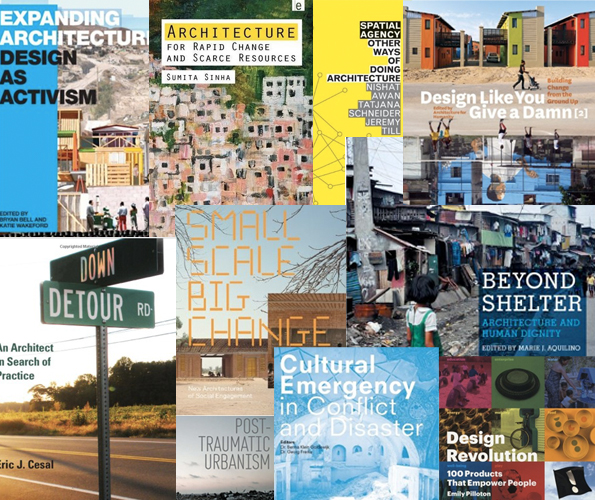The field of development-oriented architecture and design is a young yet booming area of practice, fueled by an increasing awareness of global problems and the drive to solve them through cooperation and design. This reading list features some of the most recent and relevant additions in the last few years to an equally budding realm of literature covering this field of work, listed in chronological order, starting with the newest titles.
 Design Like You Give a Damn 2 (April 2012)
Design Like You Give a Damn 2 (April 2012)
Their first volume put disaster relief architecture on the map and into design magazines; now Architecture for Humanity brings us a second helping of Design Like You Give a Damn, which we are eager to see for its updated content, new and reviewed projects, and fresh analysis of the architect’s role in development and reconstruction.
 Architecture for Rapid Change and Scarce Resources (Feb 2012)
Architecture for Rapid Change and Scarce Resources (Feb 2012)
Authored by Sumita Sinha, founder of Architects For Change, the Equality Forum at Royal Institute of British Architects, this book explores what it means for development practitioners to practice architecture on a global scale based on respect for diversity and equality and provides a blueprint for developing architectural practices based on reciprocal working methods. Through extended field research and contacts with architecture schools and architects as well as participating NGOs, it demonstrates that the ability to produce appropriate and sustainable design is increasingly relevant whether in the field of disaster relief, longer term development or wider urban contexts whether in the rich countries or poor countries.
 Beyond Shelter (July 2011)
Beyond Shelter (July 2011)
Edited by Marie Aquilino (one of our program’s visiting professors), this book compiles 20 generously illustrated reports from the field, written by the founders of some of the world’s most provocative architecture and engineering firms, studios, nonprofits, research centers and leaders of prominent organizations in the development and humanitarian field.
 Spatial Agency (June 2011)
Spatial Agency (June 2011)
Co-authored by Jeremy Till, this book offers an overview of alternative approaches to architectural practice in a changing world, making it essential reading for any architect, aspiring or practicing.
 Cultural Emergency in Conflict and Disaster (April 2011)
Cultural Emergency in Conflict and Disaster (April 2011)
Though its focus is not architecture, this book offers valuable insight on the priority of culture in processes of restoration and reconstruction. NAi Publishers gathers the input of international heritage specialists, relief workers and politicians who discuss the importance of protecting cultural heritage that is threatened by war and calamity; and reports on projects in conflict zones are augmented by contributions on international administrative and legal aspects, as well as political and socio-cultural perspectives.
 Small Scale, Big Change (Sept 2010)
Small Scale, Big Change (Sept 2010)
Released as the book format of the exhibit held at MoMA last year, Small Scale, Big Change displays the works of 11 architects and firms including Elemental, Francis Kéré and Rural Studio, among others, in underserved communities around the globe, examining the evolving standards of responsibility and participation in architecture and the ways in which architects can engage critically with larger social, economic and political issues currently facing communities around the world.
 Post Traumatic Urbanism (Sept 2010)
Post Traumatic Urbanism (Sept 2010)
Post-traumatic urbanism demands of architects the mobilisation of skills, criticality and creativity in contexts in which they are not familiar. This book explores examples of post-traumatic urban conditions in order to rethink the agency of architecture and urbanism in the contemporary world. You can find an extended review of the book over at thepolisblog.
 Down Detour Road (Aug 2010)
Down Detour Road (Aug 2010)
In this autobiographical account, Eric J. Cesal tells the story of many a young architect today facing the financial meltdown and finding a meaningful purpose to the practice of architecture. The winding detour across the country, around the profession, and into a new architectural reality will inspire aspiring and practicing architects alike hungry to make a difference through their profession.
 Design Revolution (Oct 2009)
Design Revolution (Oct 2009)
Emily Piloton, the founder of Project H Design, a global industrial design nonprofit with eight chapters around the world, brings us this call to action and compendium of projects that although centered around product design, can serve as a reference point and case study inspiration for community-driven initiatives that aim to improve life through design.
 Expanding Architecture (Oct 2008)
Expanding Architecture (Oct 2008)
Seasoned practitioners in the field like Bryan Bell and Sergio Palleroni bring together 30 essays by leading architects and designers who describe their projects step by step, revealing the ins and outs of community-based design and offering architects practical information and first-hand advice on how to work effectively in the area of development.
And to this list we’ve taken the liberty of adding our own +1…
 Reflections on Development & Cooperation
Reflections on Development & Cooperation
The first edition of our masters program resulted in this insightful collection edited by professors and a student who take a mature and profound look at the field of development–namely the economic, social and spatial relationships within the Global North and South. The result is an unexpected perspective that explores the highly volatile state of of flux inherent to current international trends and reveals distinct opportunities for new approaches in future practice. An highly recommended commentary and analysis on development for any practicing architect or urban planner in this emerging field.
You can find more books related to this subject over at this list compiled by Public Interest Design. And if we’ve missed something essential, please let us know in the comments!


Thank you for including “Small Scale, Big Change”! My next book is in print at this moment:
http://www.hatjecantz.de/controller.php?cmd=detail&titzif=00003186&lang=en
Andres Lepik